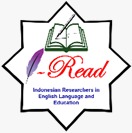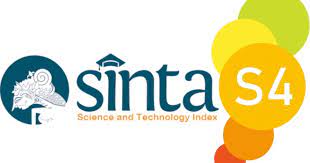The effect of “Harry Potter and Philosopher’s Stone” movie in students’ British accent pronunciation
DOI:
https://doi.org/10.22219/englie.v5i2.33602Keywords:
British Accent, Harry Potter Movie, Pronunciation AbilityAbstract
This study aimed to examine the impact of utilizing the Harry Potter movie, "Harry Potter and the Philosopher's Stone", as an educational instrument to facilitate the enhancement of year-9 SMP Negeri 06 Pontianak students' proficiency in British accent pronunciation. The research employed a pre-experimental research design, with a one-group pre-test and post-test approach, utilizing a sample of 30 IX C students selected through cluster random sampling methodology. The data were collected through pre-test and post-test assessments, which demonstrated that the result of the students' pre-test was lower than the post-test (85>16.67). Furthermore, the results indicated that the t-test exceeded the t-table value (28.47>1.699), thereby demonstrating a statistically significant effect. The results of the research analysis revealed that the null hypothesis was rejected while the alternative hypothesis was accepted. In addition, the effect size score (3.34) denoted a strong effect of the movie "Harry Potter and the Philosopher's Stone", which could be concluded that the Harry Potter movie had a very significant impact on students' ability to pronounce English words properly, particularly in British accent. The findings suggest the potential of the aforementioned movie as a medium for teaching British accent pronunciation to students, which despite on its initial purpose that the Harry Potter movie is recommended media to be used for teaching ninth-grade students.
Downloads
References
Aeni, N. M., Muthmainnah, M., Octaberlina, L. R., & Lubis, N. D. A. (2021). Accent: a literature review of English language variation on sociolinguistics. https://doi.org/10.31219/osf.io/ehx2q
Afzal, N. (2019). A study on vocabulary-learning problems encountered by ba English majors at the university level of education. Arab World English Journal, 10(3), 81–98. https://doi.org/10.24093/awej/vol10no3.6
Ahmed, Z. A. D.-A. (2017). Difficulties encountered by EFL students in learning pronunciation: a case study of Sudanese higher secondary schools. International Journal of English Linguistics, 7(4), 75–82. https://doi.org/10.5539/ijel.v7n4p75
Akhatovna, K. O. (2022). Teaching pronunciation skills. Texas Journal of Multidisciplinary Studies, 5, 279–282. https://zienjournals.com
Al-Murshidi, G. H. (2020). Effectiveness of movies in teaching and learning English as a foreign language at universities in UAE. Review Article PSYCHOLOGY AND EDUCATION, 57(6), 442–450. https://doi.org/10.17762/pae.v57i6.50
Almusharraf, A. (2022). EFL learners’ confidence, attitudes, and practice towards learning pronunciation. International Journal of Applied Linguistics (United Kingdom), 32(1), 126–141. https://doi.org/10.1111/ijal.12408
Amupanda, J. S. (2023). Research Methodology: tools and techniques. In Diamond Warriors in Colonial Namibia. https://doi.org/10.2307/jj.8155055.13
Aniuranti, A., & Suwartono, T. (2020). Teaching English allomorphs through “Harry Potter and the Chamber of Secret” movie. EduLite Journal of English Education, Literature, and Culture, 5(2), 192–201. https://doi.org/10.30659/e.5.2
Ary, D., Jacobs, L. C., Sorensen, C., & Razavieh, A. (2010). Introduction to research in education (8th Editio). Cengage Learning.
Baratta, A., & Halenko, N. (2022). Attitudes toward regional British accents in EFL teaching: Student and teacher perspectives. Linguistics and Education, 67, 1–11. https://doi.org/10.1016/j.linged.2022.101018
Beddiaf, R., & Lamri, A. (2022). The effect of technology use in learning on students’ motivation: The case of EFL students in Algeria. In university center of abdalhafid boussouf - MILA. Boussouf Abd Elhafid Mila University.
Bennour, C. F. Z. G. S. (2024). The future of E-learning : the use of technology in transforming EFL students. Kasdi Merbah Ouargla University.
Berry, D. M. (2021). Level up your pronunciation: Impact of a mobile game 1. MEXTESOL Journal, 45(1), 1–12.
Burns, A., & Seidlhofer, B. (2019). Speaking and pronunciation (Third Edit). Routledge.
Chaya, P. (2022). Movie exploratory study for appropriate cultural contents for enhancing Thai EFL students’ English-speaking skills and intercultural communicative competence. Asian Social Science and Humanities Research Journal (ASHREJ), 4(1), 1–14. https://doi.org/10.37698/ashrej.v4i1.91
Creswell, J. W. (2014). Research design: qualitative, quantitative, and mixed methods approaches (Third Edit). Sage.
Creswell, J. W., & Creswell, J. D. (2018). Research Design: Qualitative, Quantitative, and Mixed Methods Approaches (Fifth Edit). Sage.
Darcy, I. (2018). Powerful and effective pronunciation instruction: How can we achieve it? Catesol Journal, 30(1), 13–45.
Djurayeva, Y. A. (2021). Enhancing English pronunciation in learning process. CSPI Conference 2, 2, 302–306. www.ares.uz
Gilakjani, A. P., Namaziandost, E., & Ziafar, M. (2020). A survey study of factors influencing Iranian EFL learners’ English pronunciation learning. International Jornal of Research in English Education (IJREE), 5(2), 103–123. https://doi.org/10.29252/ijree.5.2.103
Goctu, R. (2017). Using movies in EFL classrooms. European Journal of Language and Literature, 3(2), 121–124. https://doi.org/10.26417/ejls.v8i1.p121-124
Haghverdi, H. R. (2015). The Effect of song and movie on high school students language achievement in Dehdasht. Procedia - Social and Behavioral Sciences, 192, 313–320. https://doi.org/10.1016/j.sbspro.2015.06.045
Hestiana, M., & Anita, A. (2022). The role of movie subtitles to improve students’ vocabulary. Journal of English Language Teaching and Learning (JELTL), 3(1), 46–53. https://doi.org/10.33365/jeltl.v3i1.1715
Hoinbala, F. R. (2022). Movies as an authentic input in l2 speaking class: A dynamic usage-based approach in EFL teaching in Indonesia. International Journal of Language Education, 6(1), 1–9. https://doi.org/10.26858/ijole.v6i1.20196
Hossan, D., Dato’ Mansor, Z., & Jaharuddin, N. S. (2023). Research population and sampling in quantitative study. International Journal of Business and Technopreneurship (IJBT), 13(3), 209–222. https://doi.org/10.58915/ijbt.v13i3.263
Hosseinzadeh, N. M., Kambuziya, A. K. Z., & Shariati, M. (2015). British and American phonetic varieties. Journal of Language Teaching and Research, 6(3), 647–655. https://doi.org/10.17507/jltr.0603.23
Iqbal, I., Naqvi, S., Abeysundara, L., & Narula, A. (2010). The Value of oral assessments: A review. The Bulletin of the Royal College of Surgeons of England, 92(7), 1–6. https://doi.org/10.1308/147363510x511030
Jahara, S. F., & Abdelrady, A. H. (2021). Pronunciation problems encountered by EFL learners: An empirical study. Arab World English Journal, 12(4), 194–212. https://doi.org/10.24093/awej/vol12no4.14
Jarosz, A. (2019). English pronunciation in l2 instruction: The case of secondary school learners. In Second Language Learning and Teaching. Springer. https://doi.org/10.1007/978-3-030-13892-9
Juma, M. J. (2021). Developing English pronunciation through animation and youtube videos. Arab World English Journal, 12(4), 401-414–414. https://doi.org/10.24093/awej/vol12no4.26
Kobilova, N. R. (2022). Importance of pronunciation in English language communication. Academic Research in Educational Sciences, 3(6), 592–597.
Levis, J. M., & Mccrocklin, S. (2018). Reflective and effective teaching of pronunuciation. In Issues in applying SLA theories toward reflective and effective teaching (pp. 77–89). https://doi.org/10.1163/9789004380882
Lengkoan, F. & Hampp. (2022). Imitation technique in learning English at English education Department Universitas Negeri Manado. Jurnal Pendidikan Bahasa Inggris Indonesia, 10(1), 48–53. https://doi.org/10.23887/jpbi.v10i1.668
Li, B., Sainath, T. N., Sim, K. C., Bacchiani, M., Weinstein, E., Nguyen, P., Chen, Z., Wu, Y., & Rao, K. (2017). Multi-dialect speech recognition with a single sequence-to-sequence model. 1-5. https://doi.org/10.48550/arXiv.1712.01541
Lightbown, P. M., & Spada, N. (2021). How languages are learned. In Issues in Applied Linguistics (Fourth Edi, Vol. 15, Issue 2). Oxford University Press. https://doi.org/10.5070/l4152005088
Lucky, S. A., Yuliana, Y. G. S., & Rezeki, Y. S. (2022). An analysis on students’ pronunciation of a scientific text. Acitya: Journal of Teaching and Education, 4(2), 475–485. https://doi.org/10.30650/ajte.v4i2.3320
Mahmood, H. A.-S. (2021). The importance of Pronunciation in English language teaching [Salahaddin University-Erbil]. https://www.researchgate.net/publication/351626037
Massai, S. (2020). Shakespeare’s accents: voicing identity in performance. Cambridge University Press.
Mataram, J. I. (2018). Using video recipe to improve the junior high school students’ ability in writing procedure text. Journal of Languages and Language Teaching, 6(2), 108–115. https://doi.org/10.33394/jollt.v6i2.1262
McCrocklin, S., & Link, S. (2016). Accent, identity, and a fear of loss? ESL students’ perspectives. Canadian Modern Language Review, 72(1), 122–148. https://doi.org/10.3138/cmlr.2582
McKay, J. M., & Hornby, A. S. (1975). Oxford Advanced Learner’s Dictionary of Current English. TESOL Quarterly, 9(1). https://doi.org/10.2307/3586015
Muhajir, M., Syafrizal, S., Nadhirah, Y. F., & Mu’izzuddin, M. (2022). Teaching pronunciation and Islamic education materials by using Harry Potter movie to Indonesian students. Journal of Language and Linguistic Studies, 18(2), 1174–1184.
Muñoz, C., Pujadas, G., & Pattemore, A. (2023). Audio-visual input for learning L2 vocabulary and grammatical constructions. Second Language Research, 39(1), 13–37. https://doi.org/10.1177/02676583211015797
Munro, M. J. (2018). How well can we predict second language learners’ pronunciation difficulties? The CATESOL Journal, 30(1), 267–281. https://eric.ed.gov/?id=EJ1174232
Pabayo, F. S., Rosnija, E., & Wajdi, M. (2022). Teaching simple past tense in narrative text using animation movie through online learning. Journal of English Education Program, 3(2), 88–94. https://doi.org/10.26418/jeep.v3i2.52141
Parmawati, A., & Inayah, R. (2019). Improving students’ speaking skill through English movie in scope of speaking for general communication. ELTIN Journal: Journal of English Language Teaching in Indonesia, 7(2), 45–53. https://doi.org/10.22460/eltin.v7i2.p43-53
Pennington, M. C., & Rogerson-Revell, P. (2019). English pronunciation teaching and research (1st ed.). Palgrave Macmillan London. https://doi.org/https://doi.org/10.1057/978-1-137-47677-7
Plailek, T., & Essien, A. M. (2021). Pronunciation problems and factors affecting English pronunciation of EFL students. Turkish Journal of Computer and Mathematics Education, 12(12), 2026–2033. https://doi.org/10.17762/turcomat.v12i12.7734
Purwanto, A. (2019). Teaching pronunciation using varieties of pronunciation teaching materials and practices. Scope: Journal of English Language Teaching, 3(2), 81–92. https://doi.org/10.30998/scope.v3i2.4129
Qizi, M. S. B. (2022). Types of received pronunciation. Science and Innovation International Scientific Journal, 1(8), 655–657. https://doi.org/10.5281/zenodo.7378099
Sanjadireja, R. R. (2020). Subtitle in teaching pronunciation with Video. IJET (Indonesian Journal of English Teaching), 9(1), 67–85. https://doi.org/10.15642/ijet2.2020.9.1.67-85
Simamora, M. W., & Oktaviani, L. (2020). What is your favorite movie?: A strategy of English education students to improve English vocabulary. Journal of English Language Teaching and Learning, 1(2), 44–49. https://doi.org/10.33365/jeltl.v1i2.604
Srakaew, P. N. (2021). The importance of pronunciation in English communication. Journal of Teaching English, 2(2), 11–18. https://so10.tci-thaijo.org/index.php/jote/article/view/491
Syam, R. R., Zuhri Dj, M., & Wahdaniati Suaib, R. (2020). British accent through Harry Potter movie as learning media: Imitating and practising the dialogue. Proceedings of the 2nd International Conference on English Language Education (ICONELE), 574.
Vančová, H. (2019). Current issues in pronunciation teaching to non-native learners of English. Journal of Language and Cultural Education, 7(2), 140–155. https://doi.org/10.2478/jolace-2019-0015
Yadav, M. S. (2020). Role of social media in English language learning to the adult learners. International Journal of Linguistics, Literature and Translation (IJLLT), 4(1), 238–246. https://doi.org/10.32996/ijllt
Yuwita, M. R., & Ambarwati, N. D. (2023). Exploring university students’ attitudes towards their English accent and native English accents. Linguistics and Literature Journal, 4(1), 21–27. https://doi.org/10.33365/llj.v4i1.2549
Downloads
Published
How to Cite
Issue
Section
License
Copyright (c) 2024 Mellyana, I. et al.

This work is licensed under a Creative Commons Attribution-ShareAlike 4.0 International License.
Authors who publish with English Learning Innovation (englie) agree to the following terms:
- For all articles published in English Learning Innovation (englie), copyright is retained by the authors. Authors give permission to the publisher to announce the work with conditions. When the manuscript is accepted for publication, the authors agree to automatic transfer of the publishing right to the publisher.
- Authors retain copyright and grant the journal right of first publication with the work simultaneously licensed under a Creative Commons Attribution-ShareAlike 4.0 International License that allows others to share the work with an acknowledgement of the work's authorship and initial publication in this journal.
- Authors are able to enter into separate, additional contractual arrangements for the non-exclusive distribution of the journal's published version of the work (e.g., post it to an institutional repository or publish it in a book), with an acknowledgment of its initial publication in this journal.
- Authors are permitted and encouraged to post their work online (e.g., in institutional repositories or on their website) prior to and during the submission process, as it can lead to productive exchanges, as well as earlier and greater citation of published work (See The Effect of Open Access).
This work is licensed under a Creative Commons Attribution-ShareAlike 4.0 International License.
















1.png)












